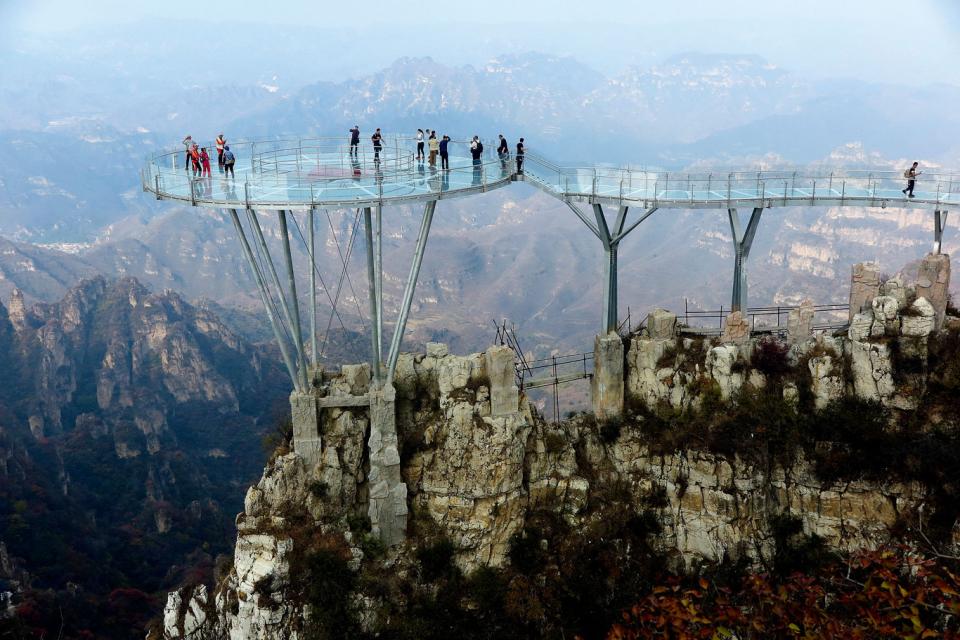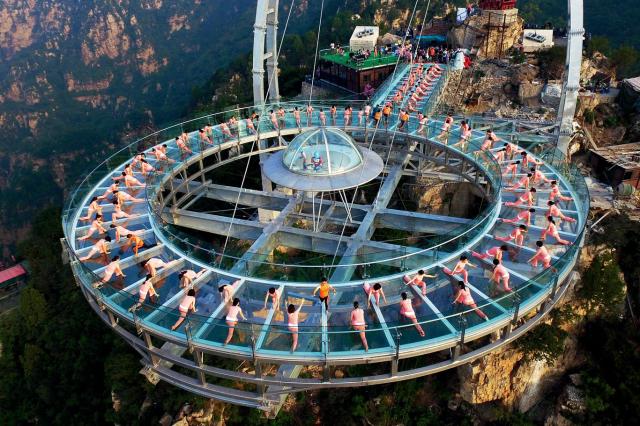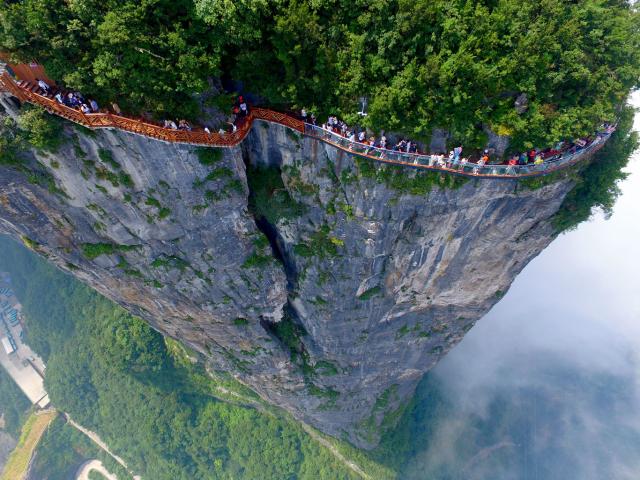China’s scenic areas have of late been in a mad rush to build glass viaducts and skywalks. China is home to some 2,300 glass bridges and sightseeing platforms, said Du Hongbo, a scenic spot investor from Maojing Cultural and Tourist Company in Beijing.
Du told NewsChina that China’s glass bridge boom started in August 2016 when Yuntiandu Bridge, then the longest glass bridge worldwide, opened in Zhangjiajie National Forest Park, a scenic area in Hunan Province known for inspiring the scenery in the film Avatar (2009). The bridge, which is 373 meters long, six meters wide and 300 meters above the valley bottom, cost more than 260 million yuan (US$37m) and took four years to build. It has since generated over 1.2 billion yuan (US$171m) in revenue and sold 7.6 million tickets.
Since then, a growing number of glass bridges and slides have been installed either in famed tourist areas or remote ecological parks even though there is no government agency in charge of construction, quality control or routine supervision. At the end of October, it was revealed that Hebei Province had closed down all 32 glass attractions spread among 24 tourists resorts for safety checks back in March 2018, and they have not yet re-opened. At the end of 2017, the glass bridge at Hongyagu Resort in Hebei Province – advertised as the world’s longest glass bridge – opened to tourists. Four months later, it was temporarily shut down over safety concerns.
“Taller, clearer and scarier,” read the website for the Langyashan Glass Platform in Hebei Province after it was completed in 2017. Visitors ascend the large circular glass platform for sweeping views above the mountains.
Over the years, scenic spots have been racing to build the longest or tallest glass bridges they could afford to attract tourists. In September 2014, Baishishan Scenic Area in Beijing built a 95-meter-long glass bridge, which at the time was the longest in China. Two glass platforms on its cliff sit 1,900 meters and 1,600 meters above sea level. In late 2017, Hongya Valley scenic spot in Hebei Province opened a 488-meter glass bridge installed 218 meters above sea level. In 2017, Guanyin Mountain scenic spot opened its 980-meter glass slide, the longest in China. Some bridges go beyond length and height to thrill tourists, such as added visual effects that make cracks seem to suddenly spider through the glass beneath tourists’ feet.
“Glass bridges could boost the development of scenic spots,” Du said. Many scenic areas were operating at a loss over the past 10 to 20 years, he explained, but glass bridges have helped them quickly turn a profit. Maren Qifeng Scenic Resort in Anhui Province previously saw 200,000 visitors annually. After its glass bridge and glass platform were built in 2017, it sold over one million tickets the following year. Yang Yanfeng, director of the Tourism College of Beijing Union University, said that according to a recent study from the Ministry of Culture and Tourism on 20,000 scenic spots nationwide, 80 percent of tourists visited the top 20-percent most popular sites. “Many scenic spots lack visitors and need new tourist products to increase their competitiveness. New attractions such as glass bridges offer a way,” he told NewsChina.
Yang said that the market for attractions such as glass bridges, glass platforms and cable cars is 100 billion yuan (US$14.3b) in China, and such upgrades are being added at lightning speed. Twenty years ago, scenic spots in China mainly depended on natural scenery to attract tourists. Nowadays, visitors are looking for more personal and interactive experiences. Beyond ticket sales, consumer considerations are crucial for scenic spot management. Glass bridges are also free from the operational expenses of traditional accommodation and catering.
“There is a relative shortage of tourist products in China, and many scenic spots are eager to offer the products of their competitors,” said Feng Liqiang, general manager of Jiangxi Plank Construction Company. “Glass bridges and walkways can easily boost visitor volume at scenic spots. With them, scenic spots don’t have to worry about attracting visitors, which is why glass bridges took off nationwide.”
However, Feng said that the success of some projects, like the Yuntiandu Glass Bridge, cannot be replicated, while places like Zhangjiajie already see over 10 million visitors a year. For scenic spots of less fame, glass bridges will bring in visitors for several months before the novelty wanes.
As an investor, Du Hongbo predicts that sightseeing attractions such as glass bridges and walkways will remain popular for three to five years before new products are introduced.
Despite the construction boom, China has no industry evaluation standards for glass bridges and slides. For example, China has a detailed catalogue of special equipment for safety supervision including boilers, pressure vessels, cableways and large recreational facilities, but glass slides are not on the list.
Over the past several years, deaths and injuries from glass slide accidents have made headlines. Visitors were injured from riding a glass slide at Huaxi World Adventure Park in Jiangsu Province over the National Day holiday on October 1, a peak period for tourism. According to reports, the slide had become too slippery from the rain. On June 5, one person died and six others were injured after falling off a slide in Guangxi Zhuang Autonomous Region.
“When accidents happen, many people think glass slides and platforms are dangerous. That’s a misconception,” Yang Yanfeng said. “It’s also a one-size-fits-all solution to close scenic spots after accidents.”
In July 2018, scholars debated the safety hazards of glass slides at a recreational facility conference in Taizhou, Zhejiang Province. They concluded that the necessary data for slide designs and tempered glass safety hazards is incomplete, and it must be specified what tempered glass grades are suitable for large recreational facilities. Scholars said that China was home to nearly 1,000 glass slides, all of which urgently need quality control checks.
Wang Zhaofeng, dean of the College of Tourism, Hunan Normal University, said safety hazards vary for different heights, locations, environments and size, all of which have different technical requirements. Meanwhile, he added, before installing glass platforms, the surrounding environment should be protected.
Du Hongbo told our reporter that technical standards for investors and construction teams are high. Designs for the Qinglianggu Glass Bridge in Beijing’s Miyun District cost 350,000 yuan (US$50,000). After its completion, the China Academy of Building Research conducted a safety evaluation. Du said that evaluation fees range between 400,000 to 500,000 yuan (US$57,000 to 71,000), the same price whether the platform costs 3 million yuan (US$428,000) or 8 million yuan (US$1.14m).
“Glass platforms make for a personal and interactive experience and there is little difference between a walkway of 100 meters or one that’s two kilometers long,” Du said. “We advise scenic spots to build glass walkways under 200 meters and spend less than two million yuan (US$286,000),” he said. “Beyond that scope, maintenance fees and safety hazards increase substantially.”
In February 2017, Song Yuzeng, director of the Beijing Tourism Commission, told media that it remains to be decided which government agency is responsible for scenic spots. The Beijing Tourism Commission had organized a conference attended by government departments in natural resources, forestry, commerce, taxation and safety to discuss the supervision of glass bridges before the Qinglianggu Glass Bridge was built.
“There have been safety loopholes for glass bridges because no agency was willing to take the lead,” said Li Yunsheng, a professor at the School of Civil Engineering, Shijiazhuang Tiedao University. An employee at a third-party quality supervision institution told NewsChina on condition of anonymity that over the past several years, national- and regional-level cultural and tourism bureaus have released regulations on the safety of glass bridges, particularly in 2019. In early 2019, the Ministry of Culture and Tourism issued a notice requiring the country’s top scenic spots to conduct technical evaluations and risk assessments of their glass bridges, walks and sightseeing platforms. The China Association for Engineering Construction is currently drafting the engineering standards for glass walks to be released in 2020.
Yang Jinsong, a deputy researcher at the China Tourism Academy, urged for a comprehensive safety supervision system to regulate the construction and operation of glass bridges. “However, specifying which agency will supervise is a priority,” he told NewsChina.

 Old Version
Old Version


